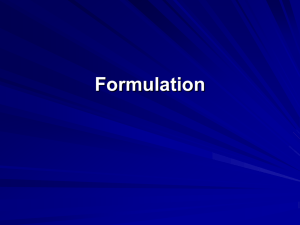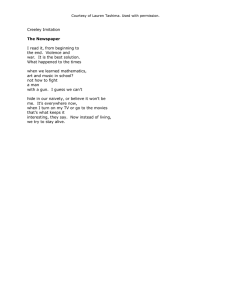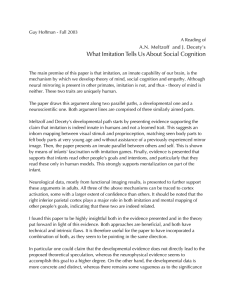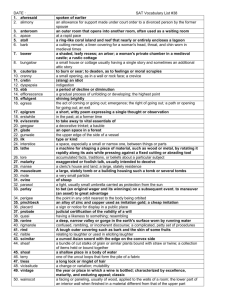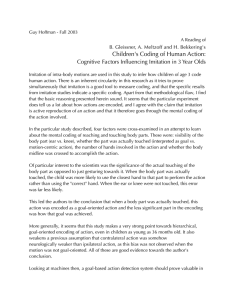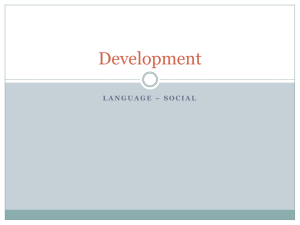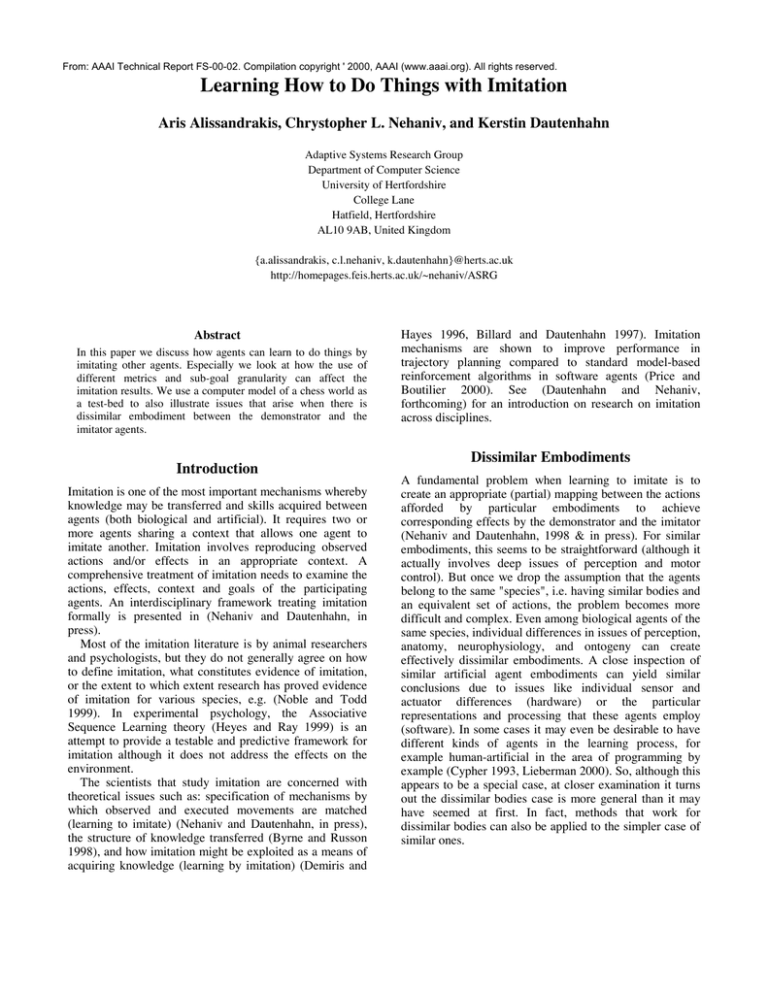
From: AAAI Technical Report FS-00-02. Compilation copyright ' 2000, AAAI (www.aaai.org). All rights reserved.
Learning How to Do Things with Imitation
Aris Alissandrakis, Chrystopher L. Nehaniv, and Kerstin Dautenhahn
Adaptive Systems Research Group
Department of Computer Science
University of Hertfordshire
College Lane
Hatfield, Hertfordshire
AL10 9AB, United Kingdom
{a.alissandrakis, c.l.nehaniv, k.dautenhahn}@herts.ac.uk
http://homepages.feis.herts.ac.uk/~nehaniv/ASRG
Abstract
In this paper we discuss how agents can learn to do things by
imitating other agents. Especially we look at how the use of
different metrics and sub-goal granularity can affect the
imitation results. We use a computer model of a chess world as
a test-bed to also illustrate issues that arise when there is
dissimilar embodiment between the demonstrator and the
imitator agents.
Introduction
Imitation is one of the most important mechanisms whereby
knowledge may be transferred and skills acquired between
agents (both biological and artificial). It requires two or
more agents sharing a context that allows one agent to
imitate another. Imitation involves reproducing observed
actions and/or effects in an appropriate context. A
comprehensive treatment of imitation needs to examine the
actions, effects, context and goals of the participating
agents. An interdisciplinary framework treating imitation
formally is presented in (Nehaniv and Dautenhahn, in
press).
Most of the imitation literature is by animal researchers
and psychologists, but they do not generally agree on how
to define imitation, what constitutes evidence of imitation,
or the extent to which extent research has proved evidence
of imitation for various species, e.g. (Noble and Todd
1999). In experimental psychology, the Associative
Sequence Learning theory (Heyes and Ray 1999) is an
attempt to provide a testable and predictive framework for
imitation although it does not address the effects on the
environment.
The scientists that study imitation are concerned with
theoretical issues such as: specification of mechanisms by
which observed and executed movements are matched
(learning to imitate) (Nehaniv and Dautenhahn, in press),
the structure of knowledge transferred (Byrne and Russon
1998), and how imitation might be exploited as a means of
acquiring knowledge (learning by imitation) (Demiris and
Hayes 1996, Billard and Dautenhahn 1997). Imitation
mechanisms are shown to improve performance in
trajectory planning compared to standard model-based
reinforcement algorithms in software agents (Price and
Boutilier 2000). See (Dautenhahn and Nehaniv,
forthcoming) for an introduction on research on imitation
across disciplines.
Dissimilar Embodiments
A fundamental problem when learning to imitate is to
create an appropriate (partial) mapping between the actions
afforded by particular embodiments to achieve
corresponding effects by the demonstrator and the imitator
(Nehaniv and Dautenhahn, 1998 & in press). For similar
embodiments, this seems to be straightforward (although it
actually involves deep issues of perception and motor
control). But once we drop the assumption that the agents
belong to the same "species", i.e. having similar bodies and
an equivalent set of actions, the problem becomes more
difficult and complex. Even among biological agents of the
same species, individual differences in issues of perception,
anatomy, neurophysiology, and ontogeny can create
effectively dissimilar embodiments. A close inspection of
similar artificial agent embodiments can yield similar
conclusions due to issues like individual sensor and
actuator differences (hardware) or the particular
representations and processing that these agents employ
(software). In some cases it may even be desirable to have
different kinds of agents in the learning process, for
example human-artificial in the area of programming by
example (Cypher 1993, Lieberman 2000). So, although this
appears to be a special case, at closer examination it turns
out the dissimilar bodies case is more general than it may
have seemed at first. In fact, methods that work for
dissimilar bodies can also be applied to the simpler case of
similar ones.
What to Imitate
A Chess World Model
The structure of knowledge transferred in learning how to
do things by imitation is another fundamental problem. The
interacting agents might have different goals and receive
different rewards. The imitator must first examine whether
the demonstrator's actions are beneficial or relevant to his
own tasks and then extract a possible behaviour to imitate.
A distinction between different modes of imitation can
be made. Low level imitation of replicating the same
actions, or high level imitation of deriving the purpose and
performing (not necessary the same) actions to that end.
The purpose of the imitation relates to the degree of its
success. Using the example of imitating a dance instructor,
one might choose to imitate only the end result, e.g. reach a
specific location on the dance floor. This can be done
either by following the path that the instructor used or
maybe ignoring it (partially or totally). The imitator can
also try to do the dance steps that the instructor performed
while moving on that path. In this example choosing to
ignore either the path or the actions that need to be
performed in the exact order of sequence will result in poor
imitation according to most dance judges. This is especially
true because as external observers they can be unaware of
the goals and priorities that the imitator has chosen. Using
a different granularity, i.e. distinguishing which are the
important aspects of the demonstrated performance and
dividing them into a number of sub-tasks, can produce
different results.
In the case of imitating the painting of a wall, the
situation is quite different. The net result, i.e. covering the
entire wall with paint can be achieved in numerous ways
and the order of paintbrush strokes in the sequence is not
important. Neither is replicating the exact actions; the use
of a brush of different width or type than the one used in
the demonstration is not important here, nor is the use of a
ladder to make reaching the higher part of the wall easier.
Replicating exactly the same hand movements as the
demonstrator, but being far from the wall without the brush
making actual contact with the surface will result in failure
due to misinterpretation of the desired effect.
Using the same example we can also point out that even
if the entire wall is finally covered, any paint stains on the
floor or the rest of the room will undermine the overall
result. Therefore, taking into account the effects on the
environment can affect the success of the imitation.
The observed actions' point of reference - whether it is
absolute or relative - poses another important issue. If any
of the actions performed by the demonstrator are not
mirror-symmetric, choosing among the possible versions
will affect the imitation result, e.g. if I want to imitate
somebody that raises her right hand should I raise my right
or left hand?
The issues discussed above are mostly ignored or
simplified in the majority of the current research on
imitation. Our work addresses most of them, using as one
test-bed an agent model implemented in the Swarm
simulation system. The study of these fundamental
imitation issues is done without restricting to any specific
application domain, illustrating instead general principles
in learning to do things using imitation in adaptive systems.
The model world consists of a chessboard, on which the
different chess pieces engage in imitation behaviours.
Movement rules for each kind of chess pieces are different,
so effectively they represent different embodiment
instances. A chess piece, acting as a demonstrator,
performs a sequence of moves that in turn each of the chess
piece types must try to imitate. The imitators apply a metric
to internally evaluate possible actions for a successful
imitation. Using the values from the metric, they choose a
best corresponding (sequence of) moves to achieve a
sequence of successive sub-goals. They are given the task
of trying to imitate the demonstrator's behaviour at a
particular level of granularity, which determines the subgoals (see below).
Although the model uses elements of chess, the intention
in doing so is to help illustrate some issues in the study of
imitation using a familiar context, and not to consider
aspects of the game of chess itself. The different chess
pieces use simple, well-defined moves in a discrete world
and as such they are very well suited for the study of
imitation in simple dissimilar embodiments.
The simple imitation technique used in the model tries to
reduce the value of a metric between the outcome of a
possible action, i.e. the distance between the square that the
piece will land on if that action is taken, and a desired
effect, i.e. reaching another sub-goal square on the board.
In order to know what to imitate, the imitator observes1 a
sequence of displacements, each relative to the previous
one, which combined with a starting point result in the
demonstrator’s progression on the board. From this it
extracts a sequence of sub-goals, desired displacements, in
accordance with a particular granularity of attempted
imitation. Then, using the same origin, the imitator tries to
achieve similar displacements and reach the same sub-goal
squares as the demonstrator did, by trying out possible
moves from its repertoire and performing the most
appropriate ones for each of the sub-goals, in sequence. If
at some point along the sequence it is not possible to
1
The model does not consider deep issues of perception. It
is assumed that the imitators instantly obtain all the
required data as soon as the demonstrator completes the
demonstration, noise-free. However granularity of the
imitation determines the salience of cumulative
displacements, i.e. it determines which displacements (or
equivalently squares) are considered as sub-goals.
further minimise the value of the metric by performing any
of the possible moves, focus is transferred to the next point.
The algorithm could be effectively outlined by the
following lines of pseudocode:
IMITATION ALGORITHM PSEUDOCODE
1. Observe demonstrator’s moves.
2. Convert perceived moves to a sequence
of sub-goals for imitation depending
on granularity.
3. For each sub-goal displacement (x,y):
3a. Choose a possible move that maximally
decreases the metric distance to
(x,y).
3b. Repeat step 3a until sub-goal is
reached or there is no move that
reduces further the distance to
sub-goal.
4. Move to next sub-goal in sequence,
if any, and repeat step 3, else stop.
well known from mathematical analysis e.g. (Rudin 1976).
Of course other possible metrics (e.g. non-geometric,
behavioural metrics) could be used, including very
complex ones (Nehaniv and Dautenhahn, in press).
The measures of distance between any two squares
(x1,y1) and (x2,y2) on the chessboard used are:
Hamming metric (or one-norm):
x1 − x2 + y1 − y 2
Euclidean distance (or two-norm):
(x1 − x2 )2 + ( y1 − y 2 )2
Infinity norm:
max{x1 − x 2 , y1 − y 2 }
The different metrics provide different notions of distance
as visualised in Fig. 1 below.
The algorithm is effectively a greedy search without any
elements of planning.
The Different Pieces and Movement Rules
The different chess pieces that are used in the model are the
following:
The Rook can only move either horizontally or vertically
any number of chessboard squares in each move.
The Bishop can only move diagonally any number of
chessboard squares in each move, but as a result cannot
visit squares of opposite color.
The Queen can move along any direction any number of
chessboard squares, effectively combining the movement
rules for the Rook and the Bishop, but without the
limitation of the latter.
The King can move like the Queen but at only a single
chessboard square per move.
The Knight has the most complex rules, moving to the
diagonally opposite end of any 3 x 2 (or 2 x 3) rectangle
(see for example Fig. 3 bottom). It is considered that it
actually instantly jumps to that location, so no other
chessboard squares are visited and therefore the Knight
cannot be blocked by intervening pieces.
In this model the Pawn was not considered due to its
severe limitations (e.g. not being able to move backwards)
that make it improbable to even remotely imitate any
complex movement sequence.
Although having distinctive movement abilities, it is
reasonable to expect from pieces of different type to be
able to move in ways resembling one another, effectively
constructing a correspondence between their different
embodiments.
Metrics and Sub-goal Granularity
For the imitators to evaluate each potential action, three
different types of metric were used in the model. These are
Figure 1. The different metrics measuring the distance
between (0,0) and (x,y). The vertical axes are normalized.
The salience of sub-goals in a movement sequence
observed by the imitator induces structure on the perceptual
data it receives. Three types of granularity were used:
If the sub-goals consist only of the total replacement of
the entire sequence, this effectively provides the end point
reached by the demonstrator, and therefore the imitator will
ignore everything else and just try to reach the end goal
square.
If the sub-goals contain the total displacements caused
by each of the moves in sequence, this can be considered as
the trajectory of the demonstrator. The imitator will
sequentially try to reach the endpoints of each of the
demonstrator’s moves.
If the sub-goals include for each individual move of the
demonstrator the sub-displacements showing all the squares
that were visited in order during that move, this effectively
gives the path travelled. The imitator will try to visit
sequentially each one of the squares in the path with a
separate move.
All the cases above also include the starting point of
reference that will also be used by the imitator.
Using the Model
An exhaustive series of experiments were done using all the
combinations of different metrics and granularity, with
each of the different chess piece types attempting then to
imitate the demonstrator. Detailed results will appear in a
forthcoming publication due to length restrictions. The
results shown here illustrate the most important observed
phenomena.
Figure 2. Sequence of moves performed by the demonstrator.
The sequence that was used for imitation in the
experimental runs of the model is shown in Figure 2. The
demonstrator is assumed to be a Queen, although it could
also be a Rook since only horizontal and vertical moves are
involved. This demonstration example is used throughout
the rest of the paper.
In many cases, more than a single corresponding solution
is found, especially by the Bishop and Knight. However
often restrictions due to differences of embodiment make it
possible only to attain some of the sub-goals in the
sequence. For example in Fig. 3, the Bishop (top) cannot
reach the final square in the demonstrator sequence as this
is of opposite color. But it actually manages to sequentially
visit all the same color squares in the path and in doing so
performs well: it stays as close to the path as is possible,
given the specified granularity and its embodiment
limitations. The Knight (bottom) is trying to imitate at
trajectory level granularity, and achieves only one out of
three of the sub-goals, thus performing more poorly as well
as not reaching the final square. However its trajectory
does generally match the one of the demonstrator Queen
and it at least does get within distance 1 of each sub-goal.
Figure 3. Bishop imitating demonstrator path using Euclidean
metric (top) and Knight imitating demonstrator trajectory
using Hamming metric (bottom).
Observations on Metrics
The choice of metric can greatly affect the outcome of the
imitation attempt. For example in Fig. 4, due to its
embodiment, using the Hamming metric (top), the King is
unable to move more than one square at a time, so it has to
break down the sub-goal into a number of moves, when
trying to imitate at trajectory level granularity. Still the trail
resembles the one of the demonstrator. When trying to
achieve the same sub-goals but using the infinity norm
metric (bottom), the King actually deviates from the trail.
But this is accepted as it still manages to satisfy all of the
trajectory sub-goals, despite the qualitative differences
from the demonstrator’s behavior.
Table 1 above shows all possible cases in which such
“getting stuck” can happen. Although this is caused
because the algorithm examines only single moves, rather
than sequences of moves, it illustrates again that the choice
of metric can be crucial for the imitative success.
Observations on Granularity
Depending on the chosen granularity of the imitative
behaviour, very different aspects of that behaviour are
imitated as seen clearly for example in Fig. 5 below.
Figure 4. King imitating demonstrator trajectory using onenorm (top) and infinity norm (bottom).
In some cases the imitator can even get “blocked” i.e.
unable to get closer to a sub-goal by any single move. We
observe this for example for the Bishop and the Knight in
Fig. 3 above.
Metric
Rook
Bishop
Queen
King
Knight
Hamming
Euclidean
--(±1,0) or
(0,±1)
-----
--(±1,0) or
(0,±1)
-----
(±1,0) or
(0,±1)
(±1,0) or
(0,±1)
Infinity
norm
x=y
x=0 or y=0
----(±1,0) or
(0,±1) or
(±1,±1)
Table 1. All possible situations, given by a desired
displacement (x,y), where no possible move can reduce the
value of the metric. Here (x,y) is the displacement of the next
sub-goal relative to the current location.
Figure 5. Rook imitating demonstrator at trajectory (top) and
end result (bottom) levels of granularity using the Euclidean
metric.
The Rook at a lower level of granularity (bottom) ignores
parts of the trail, seeking to satisfy only the end result,
instead of visiting all the end-points that it would if it were
considering a higher granularity (top).
Discussion
The results from the chess world model indicate how by
exposing the imitator to the demonstrator’s behaviour we
can build up partial solutions to the correspondence
problem, i.e. mapping the actions afforded by particular
embodiments to achieve similar effects. The result may
resemble the original in various degrees, which depend on
defining what is “similar” according to the metric used.
Granularity is also seen to play an important role. A partial
solution to the correspondence problem, if reused, can be
viewed as a structured case-based reasoning method for
learning how to imitate.
Even for the same embodiment with loose sub-goal
granularity the result might not “look the same” but it can
satisfy the metric used. For example considering a Queen
that moves on a straight line, an imitator Queen might
break the single move down into a number of smaller
straight moves. Conversely, another Queen could imitate,
using a single move, a demonstrator Queen that takes two
moves, to achieve horizontal and vertical displacements if
these are of equal length.
The current algorithm does not examine beyond the first
layer of possible moves i.e. a sequence of more than one
moves when considering minimising the metric, and as a
result there are cases where the imitator is getting stuck,
unable to achieve the desired effect (see Table 1). This
could be overcome by applying already known
correspondences (based on previous experience) instead of
trying to solve the problem every time. For example,
although the Knight is unable to immediately reduce the
value of the metric for an adjacent square of different color,
it could use a combination of three moves to reach exactly
that square. That combination cannot be found here as a
solution to a past problem due to the greedy nature of the
algorithm; the metric is bound to momentarily increase
while performing the sequence, although the overall result
would eventually be achieved. This can be discovered by
examining the history of the moves done in respect to the
results (desired or not) that were achieved. Alternative
corresponding moves could be accessed in case that e.g. an
obstacle is blocking the way, making some choices illegal.
A correspondence formally is a relation, not just a function
(see Nehaniv and Dautenhahn, in press).
The algorithm at present also does not examine whether
a move will satisfy anything else than the current objective.
As a result the Queen will require the same number of
moves to travel a straight line as the King would, even
though a single move would be enough. But when
considering the path type granularity for example, making a
move that at the same time satisfies more than one sub-goal
would be desirable.
The above aspects will be further addressed in
forthcoming publications.
References
Billard, A., and Dautenhahn, K. 1997. Grounding
Communication in Situated, Social Robots, In Proceedings
TIMR, Manchester, Towards Intelligent Mobile Robots
TIMR UK 97. Manchester University.
Byrne, R. W., and Russon, A. E. 1998. Learning by
Imitation: A Hierarchical Approach. Behavioural and
Brain Sciences 21: 667-684.
Cypher, A. ed. 1993. Watch What I Do: Programming by
Demonstration. MIT Press.
Dautenhahn, K. 1994. Trying to Imitate- a Step Towards
Releasing Robots from Social Isolation. In Proceedings
From Perception to Action Conference, Lausanne,
Switzerland, September 7-9, 1994, IEEE Computer Society
Press, ISBN 0-8186-6482-7, edited by P. Gaussier and J-D.
Nicoud, 290- 301.
Dautenhahn, K., and Nehaniv, C. L. eds. Imitation in
Animals and Artifacts. MIT Press. Forthcoming.
Demiris, J., and Hayes, G., 1996. Imitative Learning
Mechanisms in Robots and Humans, In Proceedings of the
5th European Workshop on Learning Robots (Bari, Italy,
July 1996), 9-16.
Heyes, C. M., and Ray, E. D. 1999. What is the
Significance of Imitation in Animals?, Advances in the
Study of Behaviour 29.
Nehaniv, C. L., and Dautenhahn, K. 1998. Mapping
between Dissimilar Bodies: Affordances and the Algebraic
Foundations of Imitation. Working Notes of Agents in
Interaction - Acquiring Competencies Through Imitation
Workshop at Automonous Agents '98 (Minneapolis, USA -May 1998).
Nehaniv, C. L., and Dautenhahn, K. 2001 (In press). Like
Me? — Measures of Correspondence and Imitation.
Cybernetics and Systems: An International Journal.
http://homepages.feis.herts.ac.uk/~nehaniv/likeme/
Lieberman, H. ed. 2000 Special section on "Programming
by Example", Communications of the Association For
Computing Machinery, March 2000, 43(3):72-114.
Noble, J., and Todd, P. M. 1999. Is it Really Imitation? A
Review of Simple Mechanisms in Social Information
Gathering. In Proceedings of the AISB'99 Symposium on
Imitation in Animals and Artifacts: 65-73. Society for the
Study of Artificial Intelligence & Simulation of Behaviour.
Price, B., and Boutilier, C. 2000. Imitation and
Reinforcement learning in agents with heterogeneous
actions. In Proceedings of the Seventeenth International
Conference on Machine Learning (ICML-2000).
Rudin, W. 1976. Principles of Mathematical Analysis,
third edition. New York: McGraw-Hill.
Swarm
development
http://www.swarm.org
group
homepage:


